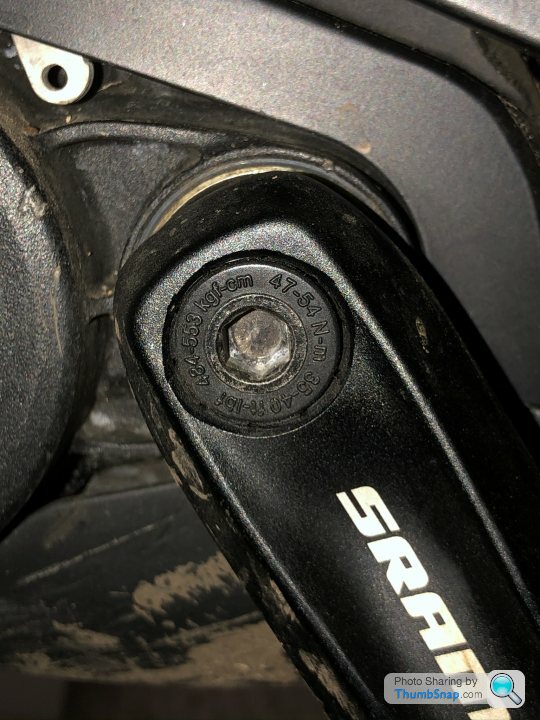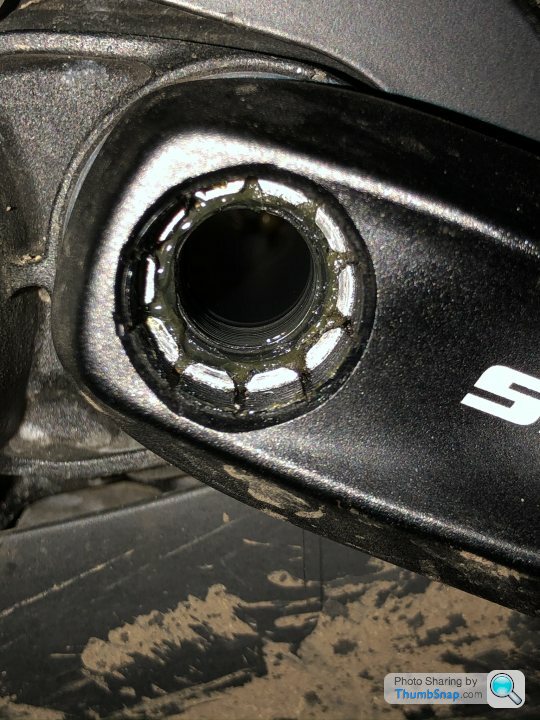How to remove crank arm...?
Discussion


All
I’m a noob to bike maintenance, but thought I’d give it a go. The crank is pretty caked with mud, and probably could do with a regrease. So, I undid the bolt on the non-drive side, which then exposed the underlying thread (see photos), However, I’m at a loss as to how to remove the crank arm so I can remove the crank from the frame. It’s stuck tight. Could someone provide a few pointers?
Cheers,
UV
robinessex said:
Go for a ride. It almost certainly will fall off when you are about 10 miles from home !! 
Do not go for a ride.
Buy or borrow a crank extractor.
Edited to add, the crank bearings are not designed to be regreased, as they are meant to be sealed for life. You can prise off the seals and repack them, but most of the time you will damage the seals doing this.
Edited by gazza285 on Wednesday 8th July 19:58
If this is a Sram GXP (not 100% clear from the photos) then it's a self-extracting system. You need to have the larger outer hollow nut screwed into the crank arm - it takes a 10 mm hex key and is tightened to a modest torque ~12 Nm. Then as said above, use an 8 mm hex key in the inner hole with substantial torque ~50 Nm turning anti-clockwise. This then pushes the crank spindle against the outer hollow nut and voila, the crank arm should begin to move away from the crank.
It's a fiendishly clever system and not at all obvious until you've done it! The important thing is the function of the outer hollow nut is purely to provide a surface to be pressed against - it does nothing to keep the crank arm in place. That's why the basic instructions mention just the 8 mm hex key. But without the outer nut nothing will be achieved. Your photo looks to have it removed but it should stay in place for both removal and reassembly. (At least that's what I found with my Sram Red yesterday, having initially forgotten the process!)
It's a fiendishly clever system and not at all obvious until you've done it! The important thing is the function of the outer hollow nut is purely to provide a surface to be pressed against - it does nothing to keep the crank arm in place. That's why the basic instructions mention just the 8 mm hex key. But without the outer nut nothing will be achieved. Your photo looks to have it removed but it should stay in place for both removal and reassembly. (At least that's what I found with my Sram Red yesterday, having initially forgotten the process!)
millen said:
If this is a Sram GXP (not 100% clear from the photos) then it's a self-extracting system. You need to have the larger outer hollow nut screwed into the crank arm - it takes a 10 mm hex key and is tightened to a modest torque ~12 Nm. Then as said above, use an 8 mm hex key in the inner hole with substantial torque ~50 Nm turning anti-clockwise. This then pushes the crank spindle against the outer hollow nut and voila, the crank arm should begin to move away from the crank.
It's a fiendishly clever system and not at all obvious until you've done it! The important thing is the function of the outer hollow nut is purely to provide a surface to be pressed against - it does nothing to keep the crank arm in place. That's why the basic instructions mention just the 8 mm hex key. But without the outer nut nothing will be achieved. Your photo looks to have it removed but it should stay in place for both removal and reassembly. (At least that's what I found with my Sram Red yesterday, having initially forgotten the process!)
First photo shows that it does not have the self extractor quite clearly.It's a fiendishly clever system and not at all obvious until you've done it! The important thing is the function of the outer hollow nut is purely to provide a surface to be pressed against - it does nothing to keep the crank arm in place. That's why the basic instructions mention just the 8 mm hex key. But without the outer nut nothing will be achieved. Your photo looks to have it removed but it should stay in place for both removal and reassembly. (At least that's what I found with my Sram Red yesterday, having initially forgotten the process!)
millen said:
If this is a Sram GXP (not 100% clear from the photos) then it's a self-extracting system. You need to have the larger outer hollow nut screwed into the crank arm - it takes a 10 mm hex key and is tightened to a modest torque ~12 Nm. Then as said above, use an 8 mm hex key in the inner hole with substantial torque ~50 Nm turning anti-clockwise. This then pushes the crank spindle against the outer hollow nut and voila, the crank arm should begin to move away from the crank.
It's a fiendishly clever system and not at all obvious until you've done it! The important thing is the function of the outer hollow nut is purely to provide a surface to be pressed against - it does nothing to keep the crank arm in place. That's why the basic instructions mention just the 8 mm hex key. But without the outer nut nothing will be achieved. Your photo looks to have it removed but it should stay in place for both removal and reassembly. (At least that's what I found with my Sram Red yesterday, having initially forgotten the process!)
Excellent guidelines! It's a fiendishly clever system and not at all obvious until you've done it! The important thing is the function of the outer hollow nut is purely to provide a surface to be pressed against - it does nothing to keep the crank arm in place. That's why the basic instructions mention just the 8 mm hex key. But without the outer nut nothing will be achieved. Your photo looks to have it removed but it should stay in place for both removal and reassembly. (At least that's what I found with my Sram Red yesterday, having initially forgotten the process!)
gazza285 said:
Do not go for a ride.
Buy or borrow a crank extractor.
Edited to add, the crank bearings are not designed to be regreased, as they are meant to be sealed for life. You can prise off the seals and repack them, but most of the time you will damage the seals doing this.
Er, that was a J O K EBuy or borrow a crank extractor.
Edited to add, the crank bearings are not designed to be regreased, as they are meant to be sealed for life. You can prise off the seals and repack them, but most of the time you will damage the seals doing this.
Edited by gazza285 on Wednesday 8th July 19:58
robinessex said:
gazza285 said:
Do not go for a ride.
Buy or borrow a crank extractor.
Edited to add, the crank bearings are not designed to be regreased, as they are meant to be sealed for life. You can prise off the seals and repack them, but most of the time you will damage the seals doing this.
Er, that was a J O K EBuy or borrow a crank extractor.
Edited to add, the crank bearings are not designed to be regreased, as they are meant to be sealed for life. You can prise off the seals and repack them, but most of the time you will damage the seals doing this.
Edited by gazza285 on Wednesday 8th July 19:58
Hi
Thanks for the help. It's a three piece SRAM Eagle SX Crankset without a self-extractor. So the crank puller looks like the way to go.
I'm wondering whether we should have a bike maintenance / mechanics sticky...thoughts?
I have many more questions... such as is it worth degreasing and regreasing a SRAM GX derailleur? Its actually pretty clean at the moment, but is this a routine task that should be considered - I'm trying to avoid removing the unit at the moment as I don't fancy (yet) having to reindex my gears!
Cheers,
UV
Thanks for the help. It's a three piece SRAM Eagle SX Crankset without a self-extractor. So the crank puller looks like the way to go.
I'm wondering whether we should have a bike maintenance / mechanics sticky...thoughts?
I have many more questions... such as is it worth degreasing and regreasing a SRAM GX derailleur? Its actually pretty clean at the moment, but is this a routine task that should be considered - I'm trying to avoid removing the unit at the moment as I don't fancy (yet) having to reindex my gears!
Cheers,
UV
One extra thing to add. If you have as I did, an extraction tool fitted and the load approaching thread-strippng levels and still nothing wants to budge; try boiling up the kettle and pouring it over the pedal crank at the spindle end. Assuming the crank is light alloy and the spindle is steel, the crank will expand more than the spindle and make it easier to get off.
In my case after pouring the boiling water on, a few blows from a copper mallet on the end of the extraction tool enabled it to be tightened about 20 degrees or so between each set of blows, untill the crank eventually came off.
In my case after pouring the boiling water on, a few blows from a copper mallet on the end of the extraction tool enabled it to be tightened about 20 degrees or so between each set of blows, untill the crank eventually came off.
Many thanks all
I now have a universal extractor with the appropriate thread to prize off the crank arm. I'm still in two minds whether the go ahead, mainly because:
1. it's an ebike, and I'm unclear on whether the crank is also attached to the motor - and whether this will prevent a clean removal of the crank
2. it will fix the clicking / creaking from the crank (this was the main reason I wanted to remove and clean it).. could this be more to do with running a "dry" chain - i.e. only using dry lube (albeit regularly)
any thoughts on the above?
cheers,
UV
I now have a universal extractor with the appropriate thread to prize off the crank arm. I'm still in two minds whether the go ahead, mainly because:
1. it's an ebike, and I'm unclear on whether the crank is also attached to the motor - and whether this will prevent a clean removal of the crank
2. it will fix the clicking / creaking from the crank (this was the main reason I wanted to remove and clean it).. could this be more to do with running a "dry" chain - i.e. only using dry lube (albeit regularly)
any thoughts on the above?
cheers,
UV
Gassing Station | Pedal Powered | Top of Page | What's New | My Stuff




